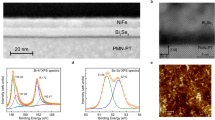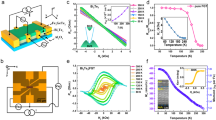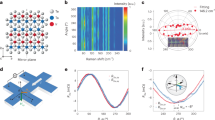Abstract
The wider application of spintronic devices requires the development of new material platforms that can efficiently be used to manipulate spin. Bismuthate-based superconductors are centrosymmetric systems that are generally thought to offer weak spin–orbit coupling. Here we report a large spin–orbit torque driven by spin polarization generated in heterostructures based on the bismuthate BaPb1−xBixO3 (which is in a non-superconducting state). Using spin-torque ferromagnetic resonance and d.c. nonlinear Hall measurements, we measure a spin–orbit torque efficiency of around 2.7 and demonstrate current-driven magnetization switching at current densities of 4 × 105 A cm−2. We suggest that the unexpectedly large current-induced torques could be the result of an orbital Rashba effect associated with local inversion symmetry breaking in BaPb1−xBixO3.
This is a preview of subscription content, access via your institution
Access options
Access Nature and 54 other Nature Portfolio journals
Get Nature+, our best-value online-access subscription
$29.99 / 30 days
cancel any time
Subscribe to this journal
Receive 12 digital issues and online access to articles
$119.00 per year
only $9.92 per issue
Buy this article
- Purchase on Springer Link
- Instant access to full article PDF
Prices may be subject to local taxes which are calculated during checkout




Similar content being viewed by others
Data availability
The data that support the findings of this study are available from the corresponding author on reasonable request.
References
Sinova, J. et al. Spin Hall effects. Rev. Mod. Phys. 87, 1213 (2015).
Bihlmayer, G. et al. Rashba-like physics in condensed matter. Nat. Rev. Phys. 4, 642–659 (2022).
Noël, P. et al. Non-volatile electric control of spin–charge conversion in a SrTiO3 Rashba system. Nature 580, 483–486 (2020).
Manipatruni, S. et al. Scalable energy-efficient magnetoelectric spin–orbit logic. Nature 565, 35–42 (2019).
Sleight, A. W., Gillson, J. L. & Bierstedt, P. E. High-temperature superconductivity in the BaPb1−xBixO3 systems. Solid State Commun. 17, 27–28 (1975).
Cava, R. J. et al. Superconductivity near 30 K without copper: the Ba0.6K0.4BiO3 perovskite. Nature 332, 814–816 (1988).
Cox, D. E. & Sleight, A. W. Crystal structure of Ba2Bi3+Bi5+O6. Solid State Commun. 19, 969–973 (1976).
Uchida, S., Kitazawa, K. & Tanaka, S. Superconductivity and metal-semiconductor transition in BaPb1−xBixO3. Phase Transit. 8, 95–128 (1987).
Yin, Z. P., Kutepov, A. & Kotliar, G. Correlation-enhanced electron–phonon coupling: applications of GW and screened hybrid functional to bismuthates, chloronitrides, and other high-Tc superconductors. Phys. Rev. X 3, 021011 (2013).
Climent-Pascual, E. et al. Polymorphism in BaPb1−xBixO3 at the superconducting composition. Phys. Rev. B 83, 174512 (2011).
Mattheiss, L. F. & Hamann, D. R. Electronic structure of BaPb1−xBixO3. Phys. Rev. B 28, 4227–4241 (1983).
Foyevtsova, K. et al. Hybridization effects and bond disproportionation in the bismuth perovskites. Phys. Rev. B 91, 121114 (2015).
Khazraie, A. et al. Oxygen holes and hybridization in the bismuthates. Phys. Rev. B 97, 075103 (2018).
Griffitt, S. et al. Local inversion-symmetry breaking in a bismuthate high-Tc superconductor. Nat. Commun. 14, 845 (2023).
Zhang, X. et al. Hidden spin polarization in inversion-symmetric bulk crystals. Nat. Phys. 10, 387–393 (2014).
Yuan, L. et al. Uncovering and tailoring hidden Rashba spin–orbit splitting in centrosymmetric crystals. Nat. Commun. 10, 906 (2019).
Giraldo-Gallo, P. et al. Field-tuned superconductor-insulator transition in BaPb1−xBixO3. Phys. Rev. B 85, 174503 (2012).
Parra, C. et al. Signatures of two-dimensional superconductivity emerging within a three-dimensional host superconductor. Proc. Natl Acad. Sci. USA 118, e2017810118 (2021).
Harris, D. T. et al. Superconductivity-localization interplay and fluctuation magnetoresistance in epitaxial BaPb1−xBixO3 thin films. Phys. Rev. Mater. 2, 041801 (2018).
Sunko, V. et al. Maximal Rashba-like spin splitting via kinetic-energy-coupled inversion-symmetry breaking. Nature 549, 492–496 (2017).
Park, S. R. et al. Orbital-angular-momentum based origin of Rashba-type surface band splitting. Phys. Rev. Lett. 107, 156803 (2011).
Chen, X. et al. Giant antidamping orbital torque originating from the orbital Rashba–Edelstein effect in ferromagnetic heterostructures. Nat. Commun. 9, 2569 (2018).
Miron, I. M. et al. Current-driven spin torque induced by the Rashba effect in a ferromagnetic metal layer. Nat. Mater. 9, 230–234 (2010).
Sánchez, J. C. R. et al. Spin-to-charge conversion using Rashba coupling at the interface between non-magnetic materials. Nat. Commun. 4, 2944 (2013).
Lesne, E. et al. Highly efficient and tunable spin-to-charge conversion through Rashba coupling at oxide interfaces. Nat. Mater. 15, 1261–1266 (2016).
Miron, I. M. et al. Perpendicular switching of a single ferromagnetic layer induced by in-plane current injection. Nature 476, 189–193 (2011).
Fischer, M. H. et al. Superconductivity and local inversion-symmetry breaking. Annu Rev. Condens. Matter Phys. 14, 153–172 (2022).
Kim, J. et al. Coherent-strained superconducting BaPb1−xBixO3 thin films by interface engineering. Phys. Rev. Mater. 3, 113606 (2019).
Liu, L. et al. Spin-torque ferromagnetic resonance induced by the spin Hall effect. Phys. Rev. Lett. 106, 036601 (2010).
Karimeddiny, S. et al. Transverse and longitudinal spin-torque ferromagnetic resonance for improved measurement of spin–orbit torque. Phys. Rev. Appl. 14, 024024 (2020).
Slonczewski, J. C. Current-driven excitation of magnetic multilayers. J. Magn. Magn. Mater. 159, L1–L7 (1996).
Garello, K. et al. Symmetry and magnitude of spin–orbit torques in ferromagnetic heterostructures. Nat. Nanotechnol. 8, 587–593 (2013).
Kim, J. et al. Layer thickness dependence of the current-induced effective field vector in Ta|CoFeB|MgO. Nat. Mater. 12, 240–245 (2013).
Liu, L. et al. Spin-torque switching with the giant spin Hall effect of tantalum. Science 336, 555–558 (2012).
Liu, L. et al. Current-induced self-switching of perpendicular magnetization in CoPt single layer. Nat. Commun. 13, 3539 (2022).
Liu, L. et al. Current-induced magnetization switching in all-oxide heterostructures. Nat. Nanotechnol. 14, 939–944 (2019).
Yoshimi, R. et al. Current-driven magnetization switching in ferromagnetic bulk Rashba semiconductor (Ge,Mn)Te. Sci. Adv. 4, eaat9989 (2018).
Zhu, L., Ralph, D. C. & Buhrman, R. A. Maximizing spin–orbit torque generated by the spin Hall effect of Pt. Appl. Phys. Rev. 8, 031308 (2021).
Giraldo-Gallo, P. et al. Stripe-like nanoscale structural phase separation in superconducting BaPb1−xBixO3. Nat. Commun. 6, 8231 (2015).
Ishizaka, K. et al. Giant Rashba-type spin splitting in bulk BiTeI. Nat. Mater. 10, 521–526 (2011).
Riley, J. M. et al. Direct observation of spin-polarized bulk bands in an inversion-symmetric semiconductor. Nat. Phys. 10, 835–839 (2014).
Gotlieb, K. et al. Revealing hidden spin-momentum locking in a high-temperature cuprate superconductor. Science 362, 1271–1275 (2018).
Wu, S.-L. et al. Direct evidence of hidden local spin polarization in a centrosymmetric superconductor LaO0.55F0.45BiS2. Nat. Commun. 8, 1919 (2017).
Yao, W. et al. Direct observation of spin-layer locking by local Rashba effect in monolayer semiconducting PtSe2 film. Nat. Commun. 8, 14216 (2017).
Santos-Cottin, D. et al. Rashba coupling amplification by a staggered crystal field. Nat. Commun. 7, 11258 (2016).
Ciccarelli, C. et al. Room-temperature spin–orbit torque in NiMnSb. Nat. Phys. 12, 855–860 (2016).
Go, D. et al. Toward surface orbitronics: giant orbital magnetism from the orbital Rashba effect at the surface of sp-metals. Sci. Rep. 7, 46742 (2017).
Haney, P. M. et al. Current induced torques and interfacial spin–orbit coupling: semiclassical modeling. Phys. Rev. B 87, 174411 (2013).
Shao, Q. et al. Strong Rashba–Edelstein effect-induced spin–orbit torques in monolayer transition metal dichalcogenide/ferromagnet bilayers. Nano Lett. 16, 7514–7520 (2016).
Wang, W. et al. Anomalous spin–orbit torques in magnetic single-layer films. Nat. Nanotechnol. 14, 819–824 (2019).
Kim, M. et al. Superconductivity in (Ba,K)SbO3. Nat. Mater. 21, 627–633 (2022).
Emori, S. et al. Ultralow damping in nanometer-thick epitaxial spinel ferrite thin films. Nano Lett. 18, 4273–4278 (2018).
Avci, C. O. et al. Current-induced switching in a magnetic insulator. Nat. Mater. 16, 309–314 (2017).
Acknowledgements
C.B.E. acknowledges support for this research through a Vannevar Bush Faculty Fellowship (ONR N00014-20-1-2844) and the Gordon and Betty Moore Foundation’s EPiQS Initiative (grant no. GBMF9065). The work done by G.G. and E.Y.T. is also supported by the Vannevar Bush Faculty Fellowship (ONR N00014-20-1-2844). Transport measurements at the University of Wisconsin–Madison were supported by the Office of Basic Energy Sciences, Office of Science, US Department of Energy, under award number DE-FG02-06ER46327. The work at University of California, Berkeley, and the Lawrence Berkeley National Laboratory is supported by the US Department of Energy Quantum Materials programme (I.H., S.S. and R.R.) and the Beyond Moore’s Law programme (R.R.). Previous support from the SRC JUMP-ASCENT programme is also acknowledged. Measurements at Cornell were supported by the US National Science Foundation (DMR-2104268). We thank J. A. Mittelstaedt for discussions.
Author information
Authors and Affiliations
Contributions
A.L.E., T.N., C.B.E., I.A.H. and R.R. conceived the research. A.L.E. and Y.C. grew films and fabricated devices from BPBO/Pt(Co) samples. I.A.H. grew films and fabricated devices from LSMO/BPBO samples. I.A.H., M.M.M., X.H. and D.C.R. performed the ST-FMR measurements and analysis. N.G.C. and M.S.R. conducted the nonlinear Hall I–V measurements. Y.C. and T.N. carried out the device-switching experiments. G.G. and E.Y.T. performed the theoretical calculations. S.S. performed the STEM measurements. A.L.E., N.G.C. and C.B.E. wrote the paper with contributions from all other co-authors.
Corresponding author
Ethics declarations
Competing interests
The authors declare no competing interests.
Peer review
Peer review information
Nature Electronics thanks Minu Kim, Kyoung-Whan Kim and the other, anonymous, reviewer(s) for their contribution to the peer review of this work.
Additional information
Publisher’s note Springer Nature remains neutral with regard to jurisdictional claims in published maps and institutional affiliations.
Supplementary information
Supplementary Information
Supplementary Notes 1-8, Figs. 1–9 and Table 1.
Rights and permissions
Springer Nature or its licensor (e.g. a society or other partner) holds exclusive rights to this article under a publishing agreement with the author(s) or other rightsholder(s); author self-archiving of the accepted manuscript version of this article is solely governed by the terms of such publishing agreement and applicable law.
About this article
Cite this article
Edgeton, A.L., Harris, I.A., Campbell, N.G. et al. Large spin–orbit torque in bismuthate-based heterostructures. Nat Electron 6, 973–980 (2023). https://doi.org/10.1038/s41928-023-01080-1
Received:
Accepted:
Published:
Issue Date:
DOI: https://doi.org/10.1038/s41928-023-01080-1
This article is cited by
-
Low-temperature grapho-epitaxial La-substituted BiFeO3 on metallic perovskite
Nature Communications (2024)



